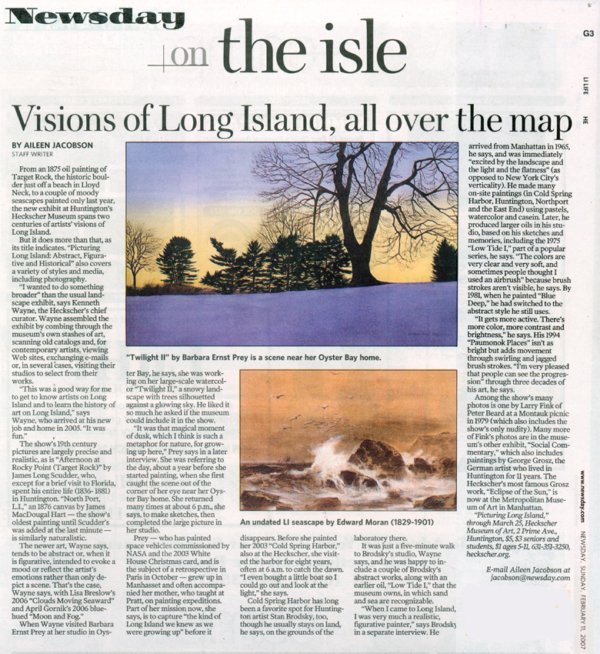Visions of Long Island, All Over the Map
Newsday
February 11, 2007
From an 1875 oil painting of Target Rock, the historic boulder just off a beach in Lloyd Neck, to a couple of moody seascapes painted only last year, the new exhibit at Huntington’s Heckscher Museum spans two centuries of artists’ visions of Long Island.
But it does more than that, as its title indicates. “Picturing Long Island:Abstract, Figurative and Historical” also covers a variety of styles and media, including photography.
“I wanted to do something broader” than the usual landscape exhibit, says Kenneth Wayne, the Heckscher’s chief curator. Wayne assembled the exhibit by coming though the museum’s own stashes of art, scanning old catalogs and, for contemporary artists, viewing Web sites, exchanging e-mails or, in several cases, visiting their studios to select from their works.
“This was a good way for me to get to know artists on Long Island and to learn the history of art on Long Island,” says Wayne, who arrived at his new job and home in 2005. “It was fun.”
The show’s 19th century pictures are largely precise and realistic, as is “Afternoon at Rocky Point (Target Rock)” by James Long Scudder, who, except for a brief visit to Florida, spent his entire life (1836-1881) in Huntington. “North Port, L.I.,” an 1876 canvas by James MacDougal Hart – the show’s oldest painting until Scudder’s was added at the last minute – is similarly naturalistic.
The newer art, Wayne says, tends to be abstract or, when it is figurative, intended to evoke a mood or reflect an artist’s emotions rather than only depict a scene. That’s the case, Wayne says, with Lisa Breslow’s 2006 “Clouds Moving Seaward” and April Gornik’s 2006 blue-hued “Moon and Fog.”
When Wayne visited Barbara Ernst Prey at her studio in Oyster Bay, he says, she was working on her large-scale watercolor “Twilight II,” a snowy landscape with trees silhouetted against a glowing sky. He liked it so much he asked if the museum could include it in the show.
“It was that magical moment of dusk, which I think is such a metaphor for nature, for growing up here,” Prey says in a later interview. She was referring to the day, about a year before she started painting, when she first caught the scene out of the corner of her eye near her Oyster Bay home. She returned many times at about 6 p.m., to make sketches, then completed the large picture in her studio.
Prey- who has painted space vehicles commissioned by NASA and the 2003 White House Christmas card, and is the subject of a retrospective in Paris in October – grew up in Manhasset and often accompanied her mother, who taught at Pratt, on painting expeditions. Part of her mission now, she says, is to capture “the kind of Long Island we knew as we were growing up” before it disappears. Before she painted her 2003 “Cold Spring Harbor,” also at the Heckscher, she visited the harbor for eight years, often at 6 a.m. to catch the dawn. “I even bought a little boat so I could go out and look at the light,” she says.
Cold Spring Harbor has long been a favorite spot for Huntington artist Stan Brodsky, too, though he usually stays on land, he says, on the grounds of the laboratory there.
It was just a five-minute walk to Brodsky’s studio, Wayne says, and he was happy to include a couple of Brodsky’s abstract works, along with an earlier oil, “Low Tide I,” that the museum owns, in which sand and sea are recognizable.
“When I came to Long Island, I was very much a realistic figurative painter,” says Brodsky in a separate interview. He arrived from Manhattan in 1965, he says, and was immediately “excited by the landscape and the light and the flatness” (as opposed to New York City’s verticality). He made many on-site paintings (in Cold Spring Harbor, Huntington, Northport and the East End) using pastels, watercolor, and casein. Later, he produced larger oils in his studio, based on his sketches and memories, including the 1975 “Low Tide I,” part of a popular series, he says. “The colors are very clear and very soft, and sometimes people though I used in airbrush” because brush strokes aren’t visible, he says. By 1981, when he painted “Blue Deep,” he had switched to the abstract style he still uses.
“It gets more active. There’s more color, more contrast and brightness,” he says. His 1994 “Paumonok Places” isn’t as bright but adds movement through swirling and jagged brush strokes. “I’m very pleased that people can see the progression” through three decades of his art, he says.
Among the show’s many photos is one by Larry Fink of Peter Beard at a Montauk picnic in 1979 (which also includes the show’s only nudity). Many more of Fink’s photos are in the museum’s other exhibit, “Social Commentary,” which also includes paintings by George Grosz, the German artist who lived in Huntington for 11 years. The Heckscher’s most famous Grosz work, “Eclipse of the Sun,” is now at the Metropolitan Museum of Art in Manhattan.

